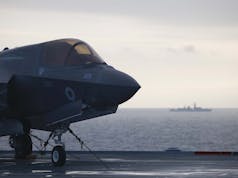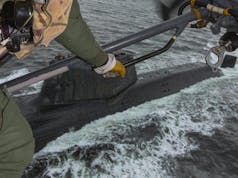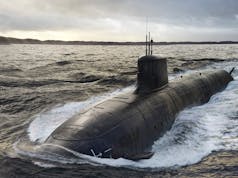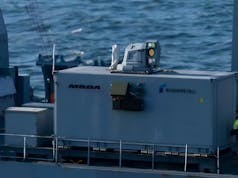The Harry S. Truman Carrier Strike Group (HSTCSG) has made its way through the Strait of Dover into the North Sea as part of a series of military operations with NATO Allies and regional partners.
According to a press release from the U.S. Navy, the strike group’s transit marks a key moment in reinforcing the long-standing strategic relationships between the United States and its European partners.

Rear Adm. Sean Bailey, commander of the HSTCSG, emphasised the importance of the deployment:
“Storied in world history, our transit through the Strait of Dover to operate with our Allies in the North Sea underscores our commitment to maritime security and the NATO Alliance. We will operate with our NATO Allies and partners to strengthen our collective readiness, defence, and deterrence.”
The Harry S. Truman Carrier Strike Group will conduct operations in the North Sea alongside various European nations. The North Sea, historically significant for both military and commercial activity, is a key strategic region where NATO forces regularly conduct joint exercises.
The area will provide the strike group with opportunities to engage in several bilateral training exercises.
The last time the HSTCSG operated in this region was in 2018, during the NATO exercise Trident Juncture, where the group ventured into the Norwegian Sea and operated above the Arctic Circle.
The task group consists of the flagship USS Harry S. Truman (CVN 75), which carries Carrier Air Wing 1 (CVW-1) with nine embarked aviation squadrons. Alongside the carrier, the strike group includes the Ticonderoga-class guided-missile cruiser USS Gettysburg (CG 64) and two Arleigh Burke-class guided-missile destroyers, USS Stout (DDG 55) and USS Jason Dunham (DDG 109).
The group is supported by staff from Destroyer Squadron 28 (DESRON 28) and Carrier Strike Group 8 (CSG-8). These vessels bring a robust array of combat power, with the ability to project air power, maintain sea control, and engage in a variety of defensive and offensive operations at sea.
As the HSTCSG enters the North Sea, it will participate in maritime operations under U.S. Naval Forces Europe, focusing on theatre security cooperation missions. The aim is to work closely with NATO Allies to ensure the security and stability of the region.
Rear Adm. Bailey underscored the importance of these operations, noting that “no nation can confront today’s challenges alone, and we look forward to showcasing our interoperability.”
Capt. Dave Snowden, commanding officer of USS Harry S. Truman, expressed enthusiasm for returning to this key operational area, having been part of the strike group during its last deployment in 2018. “With its unique geographical and environmental characteristics, every time we operate in this region we increase our proficiency and showcase our inherent flexibility to operate anywhere in the world,” Snowden said.














No mention at all about the supply ships that are with them
Cant go anywhere without them
I say this as i was in the RFA for many a year
But must say at least the USN are still a blue water navy unlike the RN who has 90% of there supply ships tied up in port
If you have access to google I suggest you read up on the USN problems with crew shortages on auxiliaries you will find pretty much the exact same issues we are having. They are in the process of laying up 17 ships to strip crews.
Likely not quite that bad.
Guessing 80% of available people manning 40% of available ships.
Either way they are not able to provide support alone, hence increasingly reliant on others.
Note sure how it will improve in the short/medium term.
the concern will be loss of skills at both ends of the hose.
The a fast combat support ship USNS Arctic (T-AOE 8) is with the strike group. I’d post photos for proof, but that doesn’t seem to be a feature here.
Correct 👍
I’ll go first… NINE Squadrons.
If we’re going to do it, then do properly.
Nine squadrons = four Super Hornet, one Growler, one super Hawkeye, one Greyhound and two Seahawk rotary squadrons.
Hi Jon keep your “ truth” and your “facts” to your self, clearly there are 10 times more planes on an American carrier than ours. Every US squadron has 12 aircraft in it and helicopters don’t count 😀
I humbly apologise for intruding on the wet dreams of so many here.
Still looking for my sock!
Surely not Hawkeye or Growler elements ? They might be part of a squadron but they’d be detached as elements of maybe four aircraft. Nor have I ever seen that many helicopters on a US carrier. Not saying I’m right and you’re wrong, just speculating. Google hasn’t, at first search, come up with the specific composition of this group’s aircraft.
Carrier Air Wing 1 embarked on USS Harry S Truman has four strike squadrons of 10 each armed with F18 EF, one EW squadron with 4 Growlers and that’s all the combat aircraft she carries, no F35’s listed.
I was being tounge and cheek for all the Russian Trolls and Chinese little pinks on here that tell us how shit the UK is for only having 12 F35B onboard.
No disrespect to the USN but 12 F35B is a far more potential air wing than 44 F18’s.
Two of the stardom’s onabord are helicopter operating sea hawk which is a far cry from Merlin.
The main advantage the Truman has is the four Hawk Eye but if the QE has an E7 near by that is far far superior to an E2.
My point being the British carriers are potent weapons even with just the current reduced compliment.
It is worth noting she is only traveling with three escorts as well just before the trolls kick off the we don’t have five with PoW.
There were four, I thought. Two T45’s & two T23’s. Normally there’d be a sub assigned as well.
HMS QE sailed with those on CSG21,HMS POW is in the North Sea training currently,she didn’t sail with any Escorts to my knowledge,a T23 and HMS Dauntless will be joining her soon for the Exercise plus HMS Astute.
McFaul is already with PoW.
USN AB McFaul is escorting PoW as well as Hms Dauntless. Mc.F had been in Faslane for a few days prior.
You can see her leaving Faslane on NL twitter, that was 4 days ago.
Ok, thanks.
The MH-60R and S squadrons are assigned to the carrier, but some of the Rs are then usually divvied up amongst the escorts, in this case the Gettysburg and Jason Dunham, as they have hangar facilities while the Stout does not. The helicopters are usually some of the busiest aircraft, as in addition to their assigned duties they often fly in support of dry stores/ammo underway replenishments.
Not sure it is that bad.
Suspect more like 80% of the personnel required to keep 50% of the fleet at sea, or at Short Notice to go to sea.
The figures are both ‘guestimates’.
As ex-Army, can someone with more naval experience tell me how are the huge “islands” on carriers counterbalanced? Is there a huge lump of summat heavy on the opposite side, or is the vessel designed with thicker, heavier stuff on the other side? Is it ballast tanks full of fuel/water? Also, why, in my very limited observations do all a/c carriers have the islands on the RHS?
Engines/reactors are offset from centre line mostly.
Ha! Simples👍
Ta
Ballasting is key. It isn’t just weight but metacentric weight that affects stability.
Huge amounts of fuel and water are moved off and on a carrier. Far more than the weight of the island.
The stability of the platform is also critical for flying ops. And controlling which tanks and their load out is part of that.
Now you have to explain to me the term “metacentric”.
Ta
Carriers are designed and constructed under Naval Architecture supervision with the hull in perfect balance, operational trim is achieved by using onboard computer controlled internal trim tanks, who compensate for daily aviation fuel use and crew watering facility.
We need to get back to using the term super carrier to describe vessels. There are only 13 active super carriers on the planet and we have two of them.
That’s not bad for a small island in the North Atlantic with a middle sized population.
Here are the other world powers listed by number of super carriers in service
Russia 0
Japan 0
Germany 0
France 0
Italy 0
India 0
Whilst a patriotic fellow, i wouldnt class the two QE carriers as “super carriers”. Not to say they are not impressive or highly capable, but 24 f35s and 14 or so helicopters just doesnt seem to put it into this capacity. I understand they are “supposed” to be able to carry many more, but I have yet to see anything solidifying that they can routinely operate with more than around 40 air-craft assets (which is still highly capable, especially where the carriers are able to support a decent sortie rate).
The design of the QEs was driven by the ambition to broadly match US carrier sortie rates ( Adm West evidence in 2004 to the DSC). If we could afford the originally planned numbers of F35, they would indeed be supercarriers.
Whether that ambition was sensible is questionable.
The 36 aircraft will be achievable once the second F35 tranche is bought but it won’t be sustainable on a permanent basis or needed. It’s worth noting as well the F35 we are getting is significantly more capable than the F35 that was envisaged in 2004. No navy has ever embarked more than 20 Fifth gen aircraft at sea before.
This is somewhat correct but also misleading, yes the deign was to support a decent sortie rate (which does roughly match the yanks on a plane to plan basis) and provide interoperability with allied forces, but it was NOT to match the overall number of sortie rate performed by a us carrier.
Looking into it to refresh my memory it was 420 sorties over 5 days (84 a day) with a maximum of 110 over 24hours based upon 36 aircraft. This works out at 2.33 sorties a day.
Us george class carrier sortie rate is around 160 a day for 30 days. Although i understand this is a bit contentious, at the lower end it gives 120 a day, or roughly 2 per aircraft, but again that can be sustained for weeks at a time.
The term super carrier has previously been defined as 65,000 tonnes when the Forestall class was launched. It has nothing to do with the current size of the air wing. As I pointed out above Truman is only carrying 44 F18’s but it doesn’t make her any less a super carrier.
They are indeed super-carriers. Definition always was one that was 50-60k tonnes or more. Nothing to do with numbers of embarked aircraft.
This is a bit of a bizarre point to try and debate.
There is no need to pretend our carriers are something that they are not as they are highly capable ships in their own right and are world beating when compared with the vast majority of nations. Pretending that they are super carriers just detracts from this
Our carriers are not in the same league as the american ones. There is no two ways about it. Trying to call them “super carriers” implies a similarity which is factually incorrect.
A 30 second search of google has come up with the following
“super carrier – the largest type of aircraft carrier, usually deplacing over 70’000 long tonnes”
The QE displace 64000 long tonnes. However I cant really stress enough that this isnt and shouldnt really be needed to be brought up here. As it is getting into pointless semantics.
Are the carriers as capable as the american ones? No
Are they a fantastic capability in their own right? yes
I have seen the carries described as “pocket super carriers” which I would agree with more, as it shows thier capability and differentiates them from the american actual super carriers.
Thanks. I seem to remember that supercarrier was one over 50 or 60,000 tonnes.
No ASW frigates?
The USN doesn’t have any ( yet ) ,hence the Connie Class debacle 🤓.
Ohhh! How does the USN deal with enemy subs then?
They use their own subs for CSG ASW a lot more than we do, I think.
They also have ABs with sonar and helicopters as a basic ASW cordon.
After the record of the Zumwalt and Little Crappy Ships (LCS) class debacles, approaching the Consternation class saga w/ equal proportion of scepticism and concern. Not certain what the Great Pumpkin would generate in terms of a new battle plan, but speculate an approach to the RCN for Hunter class. If not RCN, then RAN or RN?
Google American FREMM, America at her finest.
👍
T23 is a vital part of NATO ASW. As will T26 be….yup it is that bad.
👍
Arleigh Burke destroyers have ASW. Two or three ABs, two Ticos, an auxiliary and a small undeclared number of SSNs are a pretty normal complement. With the phasing out of the cruiser class, we’ll be seeing a new normal very soon. It will be interesting to see if Constellations will be added in the 2030s
1 Tyco and 2 burkes is normal for USN these days outside of 7th fleet.
America literally doesn’t have enough cruisers to give every CSG 2 or Destroyers 3.
Thanks Jon.
True, the Abraham Lincoln strike group and Nimitz strike group already have Flight IIA Technology Insertion Burkes as Air and Missile Defense Commanders in lieu of Ticos, which are ageing out very fast now. Flight IIIs will take over the role as they come on line.
Believe that is the future plan. In the interim, could you spare a threadbare “Superpower,” currently down on its luck, a T-26 or two? Hell, even a T-23, w/ a tug, if no PGMU mod? 🤔😉
Meanwhile, back at port, assurances have been declared that design and schedule issues w/ the Consternation class will surely be resolved soon. And the SSN maintenance backlog will be magically resolved. 🙄
S**t as a threadbare “great power” down on its luck we were thinking of asking you for a few ships.
Blind leading the blind these days.
Thankfully the Chin comms keep sinking their own subs by accident, hopefully that continues long enough for us to get a few ASW escorts back to sea 😀
Yes, a significant morale boost to learn the ChiComs were/are preoccupied w/ sinking their own SSN. Now, if only that action could be replicated on a grand scale…🤔🤞😂😉🇺🇸🇬🇧
They use MH-60R Seahawk helo, as a ASW platform from their AB’s. And MH-60S’s for CSAR.
Many thanks.
The USN uses Burkes as a jack of all trades for escort missions.
Thanks Jim.
👍
The Gettysburg and both DDGs have bow sonars and towed array sonars, and the Gettysburg and Jason Dunham have helicopter hangars and can and do operate MH-60Rs for ASW. US CSGs also typically include an SSN.
It’s a good job we don’t name our carriers after former Heads of Government. HMS Tony Blair or HMS Boris Johnson just would not work!
I really wish the USN would give up its sycophantic habit of naming vessels after politicians. Examples of this include the carrier Stennis (named after a Congressman fondly remembered by the Navy brass for his valiant fights to protect their budgets) and the submarine Jimmy Carter. It is one thing when ships are named after heroic figures such as Washington and Lincoln. But all too often such naming choices seem to be exercises in sucking up and flattery.
USS Jimmy Carter was named after a famous US submariner, diplomat and peanut farmer, one of their own who made good. That’s boasting not sucking up.
Bush and Ford Naval Aviators as well. Kennedy also decorated in USN.
Agree, their naming conventions are s**t but then maybe that’s how they get the budget 😀
Great answer. Thanks.
But think of the great headlines if one of them sank!😄
I think the USS Clinton may have gone down……….
What are you implying
Tut Tut ! 😀
Yes.
However, proven to have resurfaced and gone down again.
Possibly, a great name for a sub.
Dive, dive, dive… well, he did that.
Haha! I like it. I seem to recall a story that Churchill was flattered to have a tank named after him until it was pointed out that it could be embarrassing if they proved to be unreliable, unpopular with crews or if many were lost in combat.
True. And Hitler insisted on changing the name of a pocket battleship from Deutschland to Luetzow to avoid an embarrassing headline.
All of which was true of the Churchill tank 😀